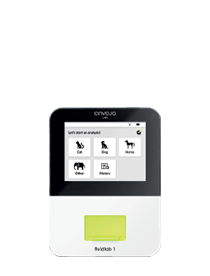Urine Microscopy in the palm of your hand
Microscopic examination of urine is carried out to screen and monitor diseases, conditions such as urinary tract infections or kidney disorders in animals. However, using automated methods in primary care can be expensive, and manual measurements can lead to inaccurate results. The disadvantage of non-standardized analysis is a challenge for veterinarians.
With the “vet fluidlab 1” state-of the art quantitative phase imaging technique, it allows automated urine microscopy of uncentrifuged urine, enabling faster diagnoses through the POC methodology and eliminating unnecessary intermediate steps in sample preparation.
Features & Functions
- Affordable solution for individuals
- Reduces the turnaround time (TAT)
- Size and portability
- Minimalistic design
- Sustainable sample carriers
- Standardized analysis
- Digital Holographic Microscopy
Digital holographic microscopy (DHM) is an innovative technique newly introduced also to the veterinary in vitro diagnostic field. In DHM, the sample is illuminated with light. As light passes through the sample, some of it gets diffracted according to its refractive index while some travels through without ‘seeing’ the sample. Behind the sample, the diffracted light interacts with the non-diffracted light, thus creating a hologram as it hits the camera. The hologram is then reconstructed digitally to retrieve an image, which contains valuable information about the different elements like blood cells, crystals or casts distributed within the sample.
Technical Data
The vet fluidlab 1 uses anvajo acella specially designed for veterinary use. The advantages of the acella sample carrier are the low sample consumption of one drop of urine (20 µl), as well as the predefined chamber height, which allows standardised, comparable results. In addition, the acella glass sample carriers can also be used under a normal microscope for comparison purposes.
| Method | Digital Holographic Microscopy |
| Sample centrifugation | No |
| Sample pipetting | Yes |
| Sample volume required for Analysis | 20µl |
| Analyzed Parameters |
|
| Consumables | Sample Carriers |
| Sample Dimensions | 0.24 kg |
Introducing: anvajo vet fluidlab 1
* For more information about vet fluidlab 1 Click Here

